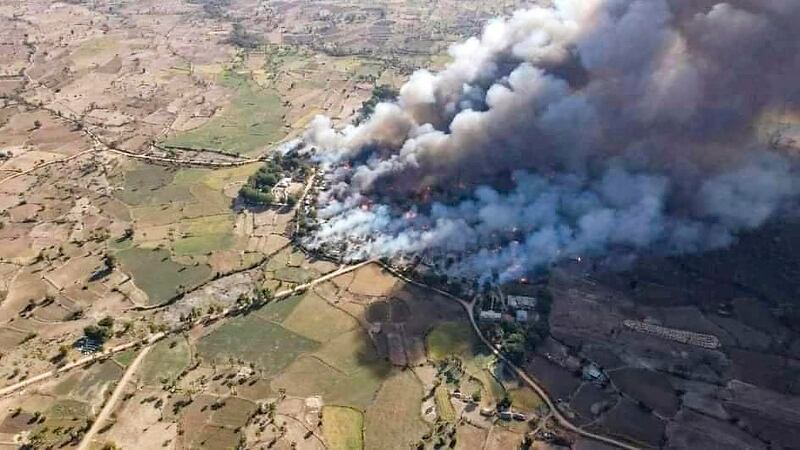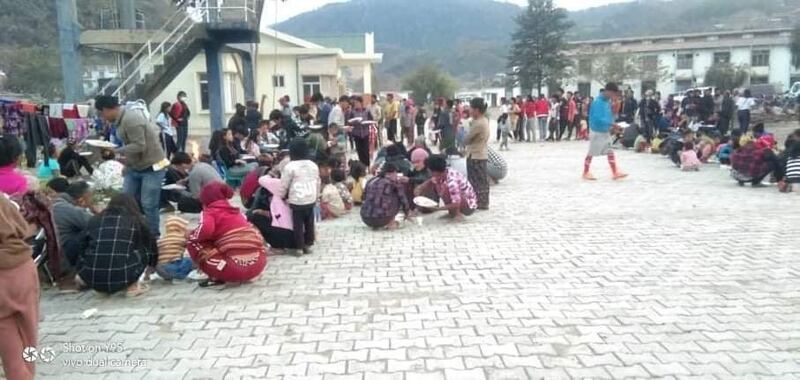A joint force of junta troops and pro-military militiamen set fire to a village in Myanmar’s embattled Sagaing region over the weekend, destroying around 250 homes and forcing more than 2,000 people to flee, residents said Tuesday.
A resident of Khin-U township’s Ngar Tin Gyi village, who spoke on condition of anonymity, told RFA’s Myanmar Service that soldiers and Pyu Saw Htee fighters stormed the settlement at around 7 a.m. on Sunday “firing guns and heavy weapons.”
“On hearing gunfire, many villagers fled with only the clothes on their backs. Some of them were able to carry some small items and food,” the resident said.
“The soldiers set some houses on fire at about 10 a.m. They stopped for a while later for lunch and then they continued burning houses again at about 2 p.m. All we could do was watch the houses burning from a distance.”
Junta forces left the next morning, he said, and residents returned to Ngar Tin Gyi to collect what was left of their belongings briefly before returning to makeshift camps in the jungle.
Another resident of Ngar Tin Gyi, who also declined to be named, said that villagers are too frightened of another raid to return to the area and rebuild.
“Smoke billowed up and I could see the flames. The terrifying sound of gunfire echoed through the air,” he said.
“All the grain and farm equipment and cattle were lost. We have nothing left – no clothes, no [rice] paddy, no food, no oil. Not a brick was left to rebuild our houses. All that we have saved throughout the years is gone now. I don’t know what to do. I cannot understand why they must be so cruel.”
Others said it would take “thirty or forty years” to rebuild everything that was destroyed over the weekend.
It was not immediately clear why Ngar Tin Gyi was targeted.
The area has seen frequent clashes between the military and anti-junta People’s Defense Force (PDF) paramilitary groups in recent weeks, and residents of other villages raided by junta forces have told RFA they were accused of providing haven to the armed opposition.
Not long after leaving Ngar Tin Gyi on Monday, the convoy of junta troops triggered a landmine planted by the PDF near Khin-U township’s Sai Gaung village. Sources said the troops responded by setting fire to a school in the village, and on Tuesday burned down three homes in nearby Ohnbin Gone village.

Scorched earth campaign
Junta Deputy Information Minister Zaw Min Tun on Tuesday called the accusations of arson attacks baseless and instead blamed the PDF, which the military regime has labeled a terrorist organization.
“[The PDF] set fire to the houses and fled and, as usual, say the army is responsible,” he said.
“They are using the term ‘Pyu Saw Htee’ in their accusations, but there is no Pyu Saw Htee. There is only a people’s militia group formed by residents [to protect themselves against the PDF].”
Since the military seized power in a Feb. 1, 2021 coup, security forces have killed at least 1,730 civilians and detained more than 10,000 political prisoners, mostly during peaceful anti-junta protests, according to the Bangkok-based Assistance Association for Political Prisoners. The junta has also launched several troop offensives against the PDF and armed ethnic groups in Myanmar’s remote border regions.
On March 3, the military shut down internet access for several townships in Sagaing region before sending troops to the area two days later. Troops have encountered fierce resistance to military rule in the region and responded with a scorched earth campaign that reports say has included arson, looting, arbitrary arrests, rape, torture, and murder.
According to an investigation by RFA, troops torched at least 447 houses in Khin-U township in the month of March alone in the villages of Dan-gone, Hmantaw, Kyunlei, Thet Pay, Tamote, Kala Lu, and Shar Lwin. The destruction since Sunday brought the total number of homes destroyed by fire in the township to nearly 700.
Data For Myanmar, a group that researches the impact of conflict on communities, recently said that pro-junta forces had burned 7,973 houses across the country since last year’s the coup. Of those, 4954 houses were in Sagaing region.
A former member of parliament from the deposed National League for Democracy party from Sagaing region told RFA that villages in Myanmar’s ethnic areas are no stranger to arson attacks by the military.
“This is undeniable. In Rakhine [state] … and in other areas like Kachin state and Chin state they have done the same thing,” said the former lawmaker, who declined to be named.
“Employing all of these horrible acts to keep the military dictatorship alive has become their tradition.”

Thousands at India border
The reports of arson attacks in Sagaing came as sources in Northern Chin state said that intensifying clashes between the military and the Chin National Defense Force (CNDF) since early March had forced nearly all the 5,200 residents of Rikhawdar in Falam township to flee to Myanmar’s shared border with India.
A resident of the town told RFA that fighting in the past week had become so bad, with junta troops indiscriminately firing mortars, that “only one percent of people remain.”
“It’s all deserted. All that is left are the people guarding their houses and belongings that they can’t take with them,” he said.
One refugee sheltering near the border said that many people had crossed into India’s Mizoram state, but “nearly 2,000” remain in makeshift camps on the Myanmar side and are running low on supplies.
“Nearly 2,000 people who cannot afford rental fees over there have been living in tents along the border with India,” he said.
“They have to find their own food and water. If the fighting continues, they will be in trouble.”
A CNDF official told RFA that the exodus was exacerbated by a March 26 military raid on his group’s camp near a border bridge in Falam township.
He said the CNDF was forced to retreat after about 45 minutes of fighting, and that “nearly all of the town’s residents immediately fled the area.”
When asked about the situation at the border, junta Deputy Information Minister Zaw Min Tun said the military is working to assist the refugees.
“Our government is taking responsibility for those who have evacuated,” he said.
“To those who are fleeing across the border, I say you are welcome to stay in our refugee camps if you are innocent and have not committed any crimes. The government is ready to provide protection to all.”
Salai Za Uk Ling, deputy executive director of the Chin Human Rights Group, dismissed the junta’s claims and said the refugees are in desperate need of international aid due to food shortages.
“There’s a shortage of food and water for those living in the [refugee] camps, so we are working on how to provide for them before the rainy season begins,” he said.
“We are still working hard to get international assistance.”
According to Salai Za Uk Ling, more than 110,000 refugees have been displaced in Chin state since the coup last year. More than 60,000 are scattered throughout the state and the remaining 50,000 have fled across the border into Mizoram, he said.
Those displaced by the recent fighting join more than 500,000 refugees from decades of conflict between the military and ethnic armed groups who were already counted as displaced at the end of 2020, according to the Internal Displacement Monitoring Center, a Norwegian NGO.
Translated by Khin Maung Nyane. Written in English by Joshua Lipes.
